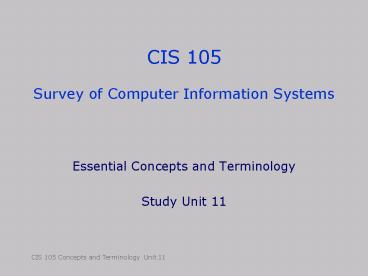CIS 105 Survey of Computer Information Systems - PowerPoint PPT Presentation
Title:
CIS 105 Survey of Computer Information Systems
Description:
... person's reputation by means of false and malicious statements. ... A false or malicious written or printed statement, or ... in bits, of an encryption code. ... – PowerPoint PPT presentation
Number of Views:24
Avg rating:3.0/5.0
Title: CIS 105 Survey of Computer Information Systems
1
CIS 105 Survey of Computer Information Systems
- Essential Concepts and Terminology
- Study Unit 11
2
Identity Theft.
- Fraudulent use of another person's identifying
information, commonly to establish a credit card
account.
3
Privacy.
- In the electronic media context, the ability to
restrict or eliminate the collection, use , and
sale of personal and confidential information.
In the jurisprudence context, the right to be
left alone.
4
Encryption.
- The process of coding information so that it can
only be understood by the intended recipient.
5
Defamation.
- Injury to another person's reputation by means of
false and malicious statements.
6
Libel.
- A false or malicious written or printed
statement, or any symbolic representation
exposing a person to public defamation.
7
Cookie.
- A file written from a Web server to a client
computer's hard disk, usually to record and
provide information about the user for future
browsing interactions.
8
Encryption Algorithm.
- The step-by-step method for encrypting and
decrypting a message.
9
Symmetric Encryption.
- Use of the same cipher key for both encryption
and decryption.
10
Data Encryption Standard (DES).
- A commonly-used, symmetric key encryption system
developed by United States security agencies.
11
Strong Encryption.
- Encryption methods that are very difficult or
impossible to break.
12
Key Interception.
- The theft of a decryption key, the major
vulnerability of encryption.
13
Public Key Encryption (PKE).
- An encryption method using two keys, a public key
to encrypt messages, and a private key to decrypt
known only to the recipient.
14
Computationally Intensive.
- Processing that placed a heavy burden on the
processing unit.
15
Cryptoanalysis.
- Techniques used to break codes.
16
Key Length.
- The length, in bits, of an encryption code. Key
lengths of 128 bits are considered invulnerable
to decryption.
17
Digital Certificate.
- A security method that validates an individual's
identity.
18
Digital Signature.
- A technique used to determine if a message has
been altered.
19
Certificate Authority (CA).
- A company that verifies the identity of
individuals and issues digital certificates
attesting to the veracity of identity.
20
Pretty Good Privacy (PGP).
- The most widely used digital signature and
certificate system.
21
End of Study Unit 11.
- Return to first slide
- Move to Study Unit 12
- CIS 105 Home Page































